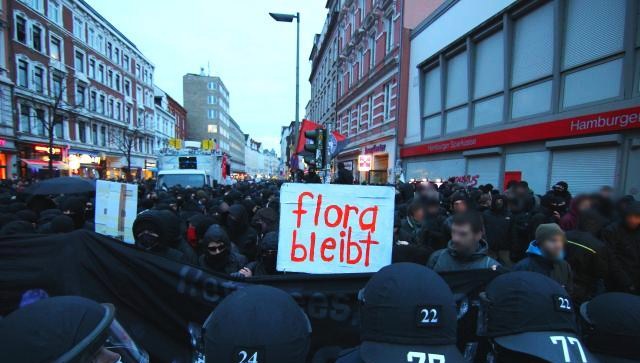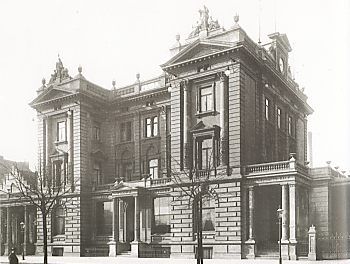
Rote Flora Bleibt – The Rote Flora Stays
Part 1
For nearly 30 years the Rote Flora, located in Hamburg’s Sternschanze Quarter, has been the centre of the struggle between the power and people of Hamburg, and its history is woven in the fabric of the terraces at the Millerntor. In fact, the keen eyed match spectators will probably have seen flags bearing the name of the former theatre showing support and love.
Since its occupation, or squat, in 1989, repeated efforts to evict squatters to allow for development of the site have been attempted, with the Burgermeister’s eventually backing down.

But what makes the Rote Flora so special? Why was it a focal point of the Anti-G20 protests and resulting backlash from security forces? Hopefully we can answer some of those questions here.
The Early Days
 The Concerthaus Flora was opened in 1888 on the site of the original Tivoli started by local businessman HFP Schmidt. Located on Schulterblatt, the street named after the whale’s shoulder blade which hung over one of the inns on the street (this bone can now be seen in the Hamburg Museum of History), it housed not only a concert hall, but a Viennese Cafe, meeting place, conservatory and gardens. It proved extremely popular with local whalers who had recently lost the Bark Flora, a permanently moored former bark ship which had been turned into a dance and beer hall.
The Concerthaus Flora was opened in 1888 on the site of the original Tivoli started by local businessman HFP Schmidt. Located on Schulterblatt, the street named after the whale’s shoulder blade which hung over one of the inns on the street (this bone can now be seen in the Hamburg Museum of History), it housed not only a concert hall, but a Viennese Cafe, meeting place, conservatory and gardens. It proved extremely popular with local whalers who had recently lost the Bark Flora, a permanently moored former bark ship which had been turned into a dance and beer hall.
By 1895, the Hamburg People’s Bank (Hamburger Volksbank) had acquired the titles, and invested money in renovations and expansions. The rise of the Vaudeville scene alongside continued interest in the theatre made the Flora a hot destination. It even got it’s own poem by opera composer Paul Lincke:
Dora – komm in die Flora,
die so viele Reize hat.
Sie liegt am Schulterblatt,
ist ganz in deiner Näh,
das schönste Varieté.Dora – come into the flora,
Which has so many charms.
It lies on the Schulterblatt,
Is quite at your fingertips,
The most beautiful variety.
Bombs, Booms and Busts
In the years following the First World War, the Flora saw many businesses using it’s upstairs spaces come and go. Alongside this, the decline of dance and music halls hit the Flora hard. Bankruptcy was filed, but not before an important bit of FC St. Pauli lore was given birth as Hans Albers was given his acting break, kick-starting his fledgling career in theatre and music halls. Hans would go on to write the musical “Das Herz von St. Pauli” in the mid-to-late 1950s. The musical’s title track is still played five minutes before kick off at the Millerntor, albeit in a more raucous and punk style than Hans’ original. Standing on the Gegengerade with the St. Pauli faithful singing along to “The Heart of St. Pauli” is one of the most unifying experiences a foreign fan can have.
Under new management, wrestling was brought to the Rote Flora, in keeping with the German idea at the time that football was “the English Disease” and that gymnastics and other events were the way to pursue athletic achievement. It proved popular, and gave the venue a new lease of life.
In the late thirties, the rear dance hall made way for a garage, although that was short lived. The horrific allied bombing put an end the garage, . Fortunately the rest of the Flora remained largely untouched and, as a result, the large remaining space was converted into a warehouse to store salvaged furniture from the bombing raids.
Post-war, there was a slight renovation before reopening, but in 1953 the venue was turned into an 800 seater cinema. This lasted until 1964 when, under new owners, it was transformed into a department store. The top two floors were removed and a flat roof put on. Again, this was short lived and by 1979 plans to restore the theatre were put in place.
Sadly, these plans were deemed too expensive and by the late 80s most of the former theatre had been demolished, and plans to rebuild behind the remaining entrance and facade came and went without success.
Part 2: Occupation and the State to follow soon.
